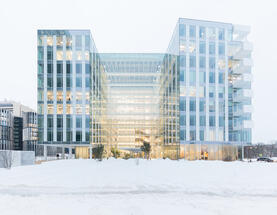"We have repeatedly encountered questions about the specific value and benefits of green building certifications for their owners. Our current analysis responds to this by comparing several key indicators that affect commercial real estate returns and potential risk management. It is interesting to compare individual markets within Europe, from which the Prague one emerges as an advanced one, in which building certification has already become the standard, "comments Jiří Stránský, head of the sustainability team at CBRE.
Certified office buildings are on the rise. The CEE region is leading by example
The share of certified buildings in the total number of offices varies greatly within individual European countries: in some cases it is in percentage units, in others it forms an absolute majority. The least certified real estate, namely 3%, is located in Lisbon, while Warsaw has the highest share (54%). "Basically, it can be said that the Central European region and its four metropolises - Prague, Bratislava, Budapest and Warsaw - have the highest share of certified buildings on the European continent with more than 40%. There are several reasons: these are relatively young markets, where modern office construction began only a few decades ago. At the same time, there is strong development activity and related competition. At the same time, the owners are also willing to additionally certify existing buildings, "says Jiří Stránský. Compared to Central European countries, some western metropolises such as Paris, Milan or Amsterdam are slightly worse - the share of certified buildings is only around 20% (since 2016 there has been an increase of 9%). However, the reason for this worse balance is not the reluctance to certify, but rather saturated construction and only limited opportunities for new projects. However, even here there is still room to increase the share of certified buildings through the certification of existing properties.
In the last five years, up to 80% of new leases in certified projects have been concluded in Prague
Demand for offices in certified buildings has increased by an average of 7 percentage points in Europe over the last five years: from 24 to 31%. The basic precondition for leasing activity is not only sufficient interest of tenants, but also the availability of suitable products on the market. For this reason, the share of leases in sustainable buildings in the total volume of concluded contracts ranges from 4% in Lisbon to as much as 80% in Prague, which is the most of all monitored cities. For comparison: in Bratislava it is about 60%, western capitals register between 20 and 30%.
The average vacancy rate in certified buildings is demonstrably lower
The vacancy rate is one of the most widely used indicators in the commercial real estate sector, reflecting the current market situation. Companies still consider the location to be the main factor when choosing office space. However, CBRE's analysis, which follows a five-year trend, clearly shows other tenants' preferences - certified sustainable buildings. They therefore have a lower vacancy rate than the office market as a whole. The biggest difference is particularly noticeable in France: in the third quarter of this year, the vacancy rate in Paris was 6.7%, while for certified buildings it was only 1.5%; in Lyon it was 4.8%, but for certified buildings it was only 0.5%. It is true that the covidu-19 pandemic last year caused an increase in the number of vacant offices, even in certified buildings: in Prague (7.02%), Budapest (9.37%) and Warsaw (12.32%). The main reason, however, is the fact that these cities also have one of the highest shares of certified buildings in European markets. "The level of corporate social responsibility is gradually increasing and the energy intensity and overall sustainability of the buildings in which they rent premises is one of the key tools in this effort. Environmental certification of buildings as a long-term proven tool is a clear guide for tenants in orienting themselves on the market, "says Jiří Stránský.
Owners of certified real estate in Prague will receive 13% more in rent
CBRE's comparative analysis also shows that owners of certified properties collect 21% more on average than owners of non-certified buildings: they achieve the most in Copenhagen (29%), Barcelona (27%) and Amsterdam (26%). In Prague it is 13%. The amount of rent is influenced, among other things, by the number of certified buildings on the market, ie the offer of competing projects. This is one of the reasons why yields in the Czech capital are lower than, for example, in Madrid or Paris. However, as early as the third quarter of 2021, it was possible to observe that the level of rent in certified buildings grew faster than the market as a whole.
"Apart from the fact that certified buildings are among the newest on the market with the highest technological standard, the willingness of tenants to pay a higher price for offices is mainly due to lower operating costs, which can partially compensate tenants for higher rents," concludes Jiří Stránský .


